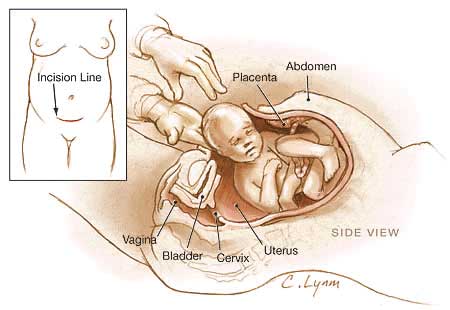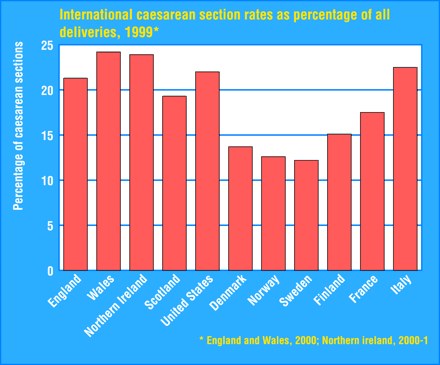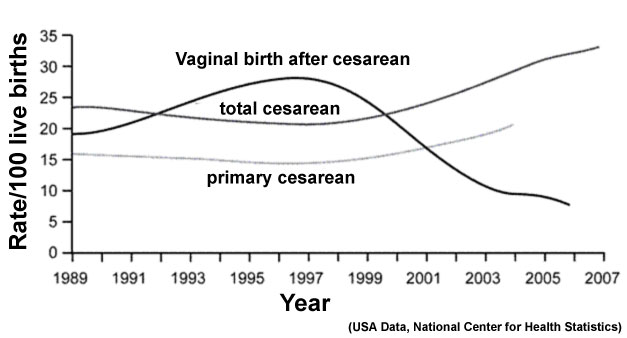Birth - Caesarean Delivery
Introduction
The term "caesarean" comes from the historic description of Julius Ceasar's birth, though probably ficticious as his mother Aurelia survived his birth. The procedure involves surgically cutting skin, abdominal wall and uterus to allow abdominal delivery.
The rate of caesarean delivery compared to normal vaginal birth is variable between countries (12-25%, 20% of all births in Australia) and increasing, particularly in older women. There are a number of different explanations as to why this is occuring, including maternal or fetal complications of either development or delivery.
Importantly this is a maternal surgical procedure which requires time for recovery and there are several studies that have looked also into the effects of caesarean delivery on potential future normal vaginal births.
Please note the UK/Australian "Caesarean" versus USA "Cesarean" spelling differences. Clinically, cesarean section may also be abbreviated to c-section or C/S.
Video Webcast: Hartford Hospital Cesarean Childbirth (September 23rd, 2005)
Recent Findings
- NIH Consensus Development Conference Draft Statement on Vaginal Birth After Cesarean: New Insights. Bangdiwala SI, Brown SS, Cunningham FG, Dean TM, Frederiksen M, Hogue CJ, King TL, Lukacz ES, McCullough LB, Nicholson W, Petit NF, Probstfield JL, Viguera AC, Wong CA, Zimmet SC. NIH Consens State Sci Statements. 2010 Mar 10;27(3). PMID: 20228855
- WHO global survey on maternal and perinatal health in Latin America: classifying caesarean sections. Betrán AP, Gulmezoglu AM, Robson M, Merialdi M, Souza JP, Wojdyla D, Widmer M, Carroli G, Torloni MR, Langer A, Narváez A, Velasco A, Faúndes A, Acosta A, Valladares E, Romero M, Zavaleta N, Reynoso S, Bataglia V. Reprod Health. 2009 Oct 29;6:18. PMID: 19874598 Reprod Health
- "Caesarean section (CS) rates have increased significantly worldwide during the last decades but in particular in middle and high income countries. In several countries of Latin America, the proportion of deliveries by CS is approaching 40% at national level. In United States, the CS rate in 2006 was 31.1%, and the latest estimates for several European countries are also above 30%. This steady increase has fuelled the debate over acceptable rates of CS and the risk-benefit analysis in ensuring optimum maternal and perinatal outcomes in different populations with different access to health resources."
- Method of delivery and pregnancy outcomes in Asia: the WHO global survey on maternal and perinatal health 2007-08. Lumbiganon P, Laopaiboon M, Gülmezoglu AM, Souza JP, Taneepanichskul S, Ruyan P, Attygalle DE, Shrestha N, Mori R, Nguyen DH, Hoang TB, Rathavy T, Chuyun K, Cheang K, Festin M, Udomprasertgul V, Germar MJ, Yanqiu G, Roy M, Carroli G, Ba-Thike K, Filatova E, Villar J; World Health Organization Global Survey on Maternal and Perinatal Health Research Group. Lancet. 2010 Feb 6;375(9713):490-9. Epub 2010 Jan 11. PMID: 20071021
- "To improve maternal and perinatal outcomes, caesarean section should be done only when there is a medical indication."
- Trends and determinants of caesarean sections births in Queensland, 1997-2006. Howell S, Johnston T, Macleod SL. Aust N Z J Obstet Gynaecol. 2009 Dec;49(6):606-11. PMID: 20070708
- "In Queensland, in 2006, CS rates were 26.9 and 48.0% among public and private sector patients, respectively. ....The CS rate in Queensland in 2006 was higher than in any other Australian state. The increase in Queensland's CS rates can be attributed to both the rising number of primary caesarean births and the rising number of repeat caesareans."
Caesarean Medical Reasons
Listed below are the main medical resons for considering a Caesarean.
- If your baby is positioned bottom first
- If you have a viral infection
- If you are expecting twins
- If your baby is small
- If your baby is premature
Comparison Caesarean Rate 1999
Image from: The National Sentinel Caesarean Section Audit Report (UK)
USA Caesarean Rate by Gestational Age
Trial of Labor
Trial of Labor (TOL) or trial of labor after cesarean (TOLAC) is a term used in relation to the offer for a normal vaginal delivery after a previous cesarean delivery. The resulting birth is described as vaginal birth after cesarean (VBAC).
Positive Factors
(increased likelihood of successful VBAC)
- Maternal age <40 years
- Prior vaginal delivery (particularly prior successful VBAC)
- Favorable cervical factors
- Presence of spontaneous labor
- Nonrecurrent indication that was present for prior cesarean delivery
Negative Factors
(decreased likelihood of successful VBAC)
- Increased number of prior cesarean deliveries
- Gestational age >40 weeks
- Birth weight >4,000 g
- Induction or augmentation of labor
Links: USA Guideline, updated 2005
External Links
- Journal of American Medical Association JAMA Patient Page: Cesarean Delivery (USA) - one page Caesarean delivery information sheet (PDF)
- electronic Med J Aust Caesarean section: a matter of choice? by de Costa, C.M. MJA 1999; 170: 572-573
References
Reviews
Articles
Search PubMed
Search Pubmed: Caesarean Delivery | Cesarean Delivery
Glossary Links
- Glossary: A | B | C | D | E | F | G | H | I | J | K | L | M | N | O | P | Q | R | S | T | U | V | W | X | Y | Z | Numbers | Symbols | Term Link
Cite this page: Hill, M.A. (2024, April 18) Embryology Birth - Caesarean Delivery. Retrieved from https://embryology.med.unsw.edu.au/embryology/index.php/Birth_-_Caesarean_Delivery
- © Dr Mark Hill 2024, UNSW Embryology ISBN: 978 0 7334 2609 4 - UNSW CRICOS Provider Code No. 00098G



